Easy Blends and Fades: Watercolor Basics
Read the comic online now!
Blending, fading, and gradation are all wet into wet techniques best applied early in the painting process. These often require saturating the paper with water or paint, then floating paint on top of that.
These techniques tend to work best on cotton rag papers. In my examples I am using Canson's Moulin du Roy and Canson's L'Aquarelle Heritage watercolor papers- both of which are mould made, cotton rag papers with a cold press finish. It seems like L'Aquarelle is the replacement for Moulin du Roy. Both papers are capable of handling A LOT of water, and are not prone to muddiness- making them ideal for blends.
For blending techniques that rely on wet into wet diffusion, I highly recommend you go with a cotton rag based paper. These techniques really do not work well on cellulose papers- believe me, I've tried over the years with 7" Kara pages. I discuss paper types in the post All About That Paper.
This post was brought to you by Ink Drop Cafe, a creator's collective. Nattosoup Studio Art and Process Blog is a proud affiliate of Ink Drop Cafe.
If you enjoy comics and art resources, you should definitely check Ink Drop Cafe out!
The blends covered in today's tutorials are all fairly easy blends to accomplish, and require no special tools- just a little bit of patience!
Types of Blends
Blends are usually achieved with wet into wet or dry into wet. Blends can also be somewhat achieved by adding water after the fact, but this is not a reliable method.
Recommended Papers:
Almost anything that is cotton rag should blend nicely.
Papers I've used:
- Canson Moulin du Roy
- Canson L'Aquarelle Heritage
- Arches Cold Press
- Fabriano Artistico
- Shizen Handmade Paper
Wet into Wet- Soft Diffused Blend:
Great for glows
Useful for toning
Useful for creating an area of focus
How to achieve this: Apply a wash of clean water (or background color). Remove pools using a 'thirsty' brush. Apply color in circular motions, starting in the middle of the area you wish to highlight and working your way outward.
Dry into Wet: Diffused Blends Within A Small Area:
Useful for:
Creating softer textures, like streaks in marble or woodgrain
Creating diffused shadows
How to achieve this: Apply your initial color- the color you want to blend your dry color into. Pick up any pooling using a paper towel or a 'thirsty' brush. Heavily mix your next color, working directly from the pan if necessarily. Gently glide into the first color while first color is still wet.
Small, Soft Blends in limited areas:
Useful For:
Painting Blends to Render Glass
How to achieve this: Blend wet paint out with water, or dab excess paint up with a paper towel, then blend with water.
Wet into Wet: Simple Sky Gradient
Useful for:
Skies
Soft transitions
How to Achieve This:
There are three methods for achieving single color gradient transitions.
The first:
Apply a wash of color to half of the area, blend out using water for the rest. Prop up so that the color area will run into the water area.
The second: Apply a wash of color with a single brush dip into paint, allowing the gradual decrease in paint to create the gradation.
The third:
Apply wash all over area. Allow to dry. Apply another wash, blending out with water about 1/3 of the way to the end. Allow to dry. Apply another wash to about 2/3 of the way to the end. Allow to dry.
Useful for:
Skies
Soft transitions
How to Achieve This:
There are three methods for achieving single color gradient transitions.
The first:
Apply a wash of color to half of the area, blend out using water for the rest. Prop up so that the color area will run into the water area.
The second: Apply a wash of color with a single brush dip into paint, allowing the gradual decrease in paint to create the gradation.
The third:
Apply wash all over area. Allow to dry. Apply another wash, blending out with water about 1/3 of the way to the end. Allow to dry. Apply another wash to about 2/3 of the way to the end. Allow to dry.
Wet into Wet: Extreme Color Gradients
Useful for :
Sunsets
Extreme color changes in plants
How to achieve this: Paint half the area in one color, absorbing excess color with a thirsty brush or a paper towel. Starting at the other end, repeat with other color. Soak up excess water to prevent pooling.
From Fuschia to Green Gold
Dabbing Color in to Gently Diffuse:
Useful for:
Reinforcing certain colors
Gently adding accent colors
How to achieve this:
Simply dab your dry-mixed color onto your wet paper.
If you enjoyed this Watercolor Basics tutorial, don't be shy! Please share it to your favorite social media! Your good word on Twitter, Tumblr, Facebook, or Pinterest goes a long way to keeping this blog going! If you're feeling particularly generous, or want access to Backer Exclusive goodies, wooden charms, mini prints, and more, join the Artnerd community on Patreon!
Love art and want to pursue an art education? Interested in sequential art like comics, animation, or storybooks? Make sure you check out the NATTO scholarship!






















Comments
Post a Comment